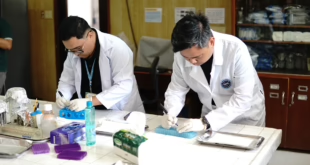By Development Communication Section

Congratulations and compliments to SEAFDEC/AQD scientist emerita Dr. Jurgenne Primavera for being recognized by the National Academy of Science and Technology, Philippines (NAST PHL) as one of its new academicians . The NAST recognizes Dr. Primavera’s significant and pioneering research contributions to the aquaculture of marine shrimp and the science-based utilization and conservation of mangroves, and to studies on critically important beach forest ecosystem. Her earlier research focused on induced maturation and broodstock development of the tiger shrimp, Penaeus monodon, and other penaeid shrimp that contributed to the growth of the shrimp farming industry.
Dr. Primavera is an internationally-recognized expert on mangroves. Her extensive studies on mangrove as nurseries for penaeid shrimp, the integration of brackishwater pond culture and mangrove for aquaculture and the science-based rehabilitation of mangroves represent a holistic approach to the sustainable use of mangroves. Dr. Primavera has also significantly contributed to the inventory of species in beach forests, including the germination trials of propagules of various species suitable for the rehabilitation of beach forests. As a scientist of the Southeast Asian Fisheries Development Center Aquaculture Department, she mentored research students, staff and trainees from the Philippines and other parts of the world.
In a related news, more congratulations are in order for SEAFDEC/AQD scientists for bagging the 2015 Outstanding Books/Monographs Award also given by NAST Philippines for their monograph titled “Health Management in Aquaculture (2nd Ed) edited by G. D. Lio-po and Y. Inui, 2010” on July 9, 2015 at the Manila Hotel, Manila, Philippines. An earlier edition of the book, “Health Management in Aquaculture edited by G.D. Lio-Po, C.R. Lavilla and E.R. Cruz-Lacierda, 2001” also won the NAST Awards for Outstanding Books/Monographs in 2004. These textbooks describe the major diseases of cultured fish and crustaceans, as well as their prevention and control; and the diagnostic techniques for these diseases. New chapters on histology, probiotics, and epidemiology were added in the second edition.


 SEAFDEC/AQD Southeast Asian Fisheries Development Center | Aquaculture Department
SEAFDEC/AQD Southeast Asian Fisheries Development Center | Aquaculture Department



